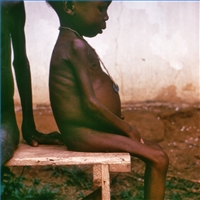 Did you ever see those grim images of protein-starved children in faraway places? “Good thing that stuff doesn’t happen here,†you mutter under a sigh of relief.
Did you ever see those grim images of protein-starved children in faraway places? “Good thing that stuff doesn’t happen here,†you mutter under a sigh of relief.
Newsflash: Protein malnutrition is closer to home than you could imagine, particularly in seniors with dwindling food intake who may not eat enough protein-rich foods.
Protein is made up of amino acids — the building blocks for muscle, enzymes, and cell structure inside the body. But here is the catch: The body does not store extra amino acids and cannot produce several so-called essential amino acids.  So what’s a protein-starved body to do? You must eat enough protein and the right types everyday to keep adequate supplies flowing. If that is not possible then protein supplements can be a valuable option.
Without enough protein intake the body swipes needed building blocks from muscles. Each decade over age 50, in fact, you can lose another 10% of your muscle mass. This weakens the body and could affect strength, balance and daily function. The infection-fighting immune system and oxygen-carrying hemoglobin in red blood cells also depend on protein. Clearly you cannot short-change protein intake for your body.
How Much Protein is Enough?
Adults age 19 to 59 years old:Â Daily need is about 8 grams protein for each 20 pounds body weight
Older adults over 60: Daily need is about 10 to 13 grams protein for every 20 pounds of body weight.
For example, a 120 pound woman who is 72 years old would need between 10 and 13 grams of protein for each 20 pounds body weight. 20 x 6 = 120 lbs. So she would 60 to 78 grams of protein to meet her daily requirements (6 x 10 = 60, 6 x 13 = 78).
Just choose several items from the chart below and add them up to reach your daily protein requirement – and you are well on your way to maintaining your independence as you age.
Where to Find Protein:
| SOURCE | Amount to Eat | Grams (gm) Protein |
| 1% Lowfat Cottage Cheese | 1 cup | 28 gm |
| Turkey | 3 Ounces | 25 gm |
| Halibut or Salmon | ½ Fillet (5.5 ounces) | 40 gm |
| Tuna Salad | 1 cup | 33 gm |
| Edamame (frozen green soybeans, cooked) | 1 cup | 17 gm |
| Sardines, canned, drained | 3.5 ounces (1 can) | 23 gm |
| Beans (Pinto, Kidney, Lima, Garbanzo, Black, Navy, Baked) | 1 cup | 15 gm |
| Herring, pickled | 3 ounces | 12 gm |
| Ground Beef | 3 ounces | 20 gm |
| Yogurt | 8 ounces | 10 to 12 gm |
| Milk, Plain or Soy | 8 ounces | 8 gm |
| Peanuts | 1 ounce | 8 gm |
| Spinach, cooked | 1 cup | 7 gm |
| Peas, green | 1 cup | 7 gm |
| Bagel | One 3.5 inch diameter | 7 gm |
| Egg, Hard boiled | 1 large | 6 gm |
| Quinoa (grain), cooked | 1 cup | 8 gm |
| Oatmeal, boiled | 1 cup | 6 gm |
| Bread, whole wheat | 1 slice | 3.5 gm |
| Peanut Butter | 2 Tablespoons | 8 gm |
| Almonds | ¼ cup | 7.5 gm |
| Cashews | ¼ cup | 5 gm |
| Pistachios | ¼ cup | 6 gm |
| Walnuts | ¼ cup | 4.5 gm |
Sources
- Chernoff, R: Protein and Older Adults. Journal of the American College of Nutrition, Vol. 23, No. 90006, 627S-630S (2004)
- Castaneda C, Charnley JM, Evans WJ, Crim MC: Elderly women accommodate to a low-protein diet with losses of body cell mass, muscle function, and immune response. Am J Clin Nutr 62 :30 –39,1995.
- Kurpad AV, Vaz M: Protein and amino acid requirements in the elderly. Eur J Clin Nutr54(Suppl) 3 :S131 –S142,2000.
- Wija, A et al: Dairy Products as Essential Contributors of (Micro-) Nutrients in Reference Food Patterns: An Outline for Elderly People. Journal of the American College of Nutrition, Vol. 27, No. 6, 747S-754S (2008).
- USDA National Nutrient Database for Standard Reference. http://www.nal.usda.gov/fnic/foodcomp/Data/SR20/nutrlist/sr20a203.pdf
